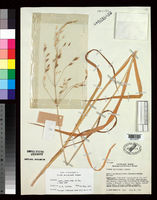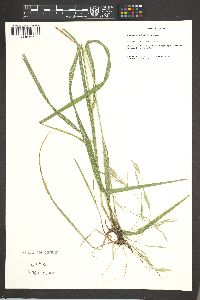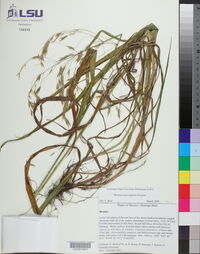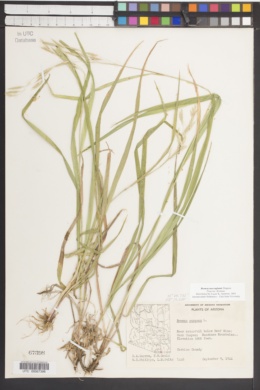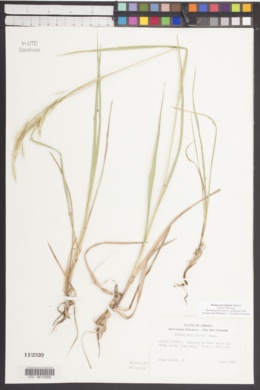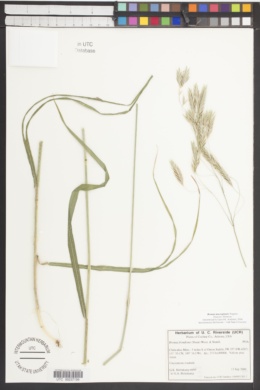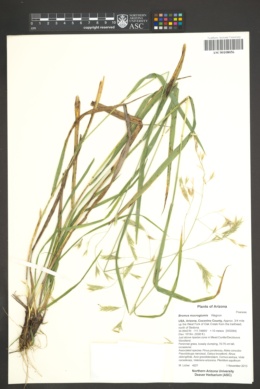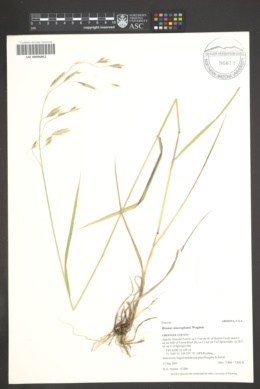Bromus mucroglumis
|
|
|
|
Family: Poaceae
Sharp-Glume Brome, more...sharpglume brome, sharp glume brome
[Bromopsis mucroglumis (Wagnon) Holub] |
Plants perennial; not rhizomatous. Culms 50-100 cm, erect or spreading; nodes 5-7, pilose or pubescent; internodes glabrous. Basal sheaths pubescent or pilose, throats pilose; upper sheaths pubescent or glabrous, midrib of the culm leaves not abruptly narrowed just below the collar; auricles absent; ligules 1-2 mm, glabrous, truncate or obtuse; blades 20-30 cm long, (4)7-11 mm wide, flat, both surfaces pilose or the abaxial surface glabrous. Panicles 10-20 cm, open, nodding; branches ascending or spreading. Spikelets 20-30 mm, elliptic to lanceolate, terete to moderately laterally compressed, with 5-10 florets. Glumes usually pilose or pubescent, rarely glabrous; lower glumes 6-8 mm, 1-veined; upper glumes 8-8.5 mm, 3-veined, mucronate; lemmas 10-12 mm, elliptic to lanceolate, rounded over the midvein, backs and margins pilose or pubescent, apices acute to obtuse, entire; awns 3-5 mm, straight, arising less than 1.5 mm below the lemma apices; anthers 1.5-3 mm. 2n = 28. Bromus mucroglumis grows at 1500-3000 m in the southwestern United States and northern Mexico. Perennials, Terrestrial, not aquatic, Stems nodes swollen or brittle, Stems erect or ascending, Stems caespitose, tufted, or clustered, Stems terete, round in cross section, or polygonal, Stem nodes bearded or hairy, Stem internodes hollow, Stems with inflorescence less than 1 m tall, Stems, culms, or scapes exceeding basal leaves, Leaves mostly cauline, Lea ves conspicuously 2-ranked, distichous, Leaves sheathing at base, Leaf sheath mostly closed, Leaf sheath smooth, glabrous, Leaf sheath hairy, hispid or prickly, Leaf sheath and blade differentiated, Leaf blades linear, Leaf blades 2-10 mm wide, Leaf blades mostly flat, Leaf blades more or less hairy, Ligule present, Ligule an unfringed eciliate membrane, Inflorescence terminal, Inflorescence an open panicle, openly paniculate, branches spreading, Inflorescence solitary, with 1 spike, fascicle, glomerule, head, or cluster per stem or culm, Inflorescence lax, widely spreading, branches drooping, pendulous, Inflorescence with 2-10 branches, Inflorescence branches more than 10 to numerous, Flowers bisexual, Spikelets pedicellate, Spikelets laterally compressed, Spikelet 3-10 mm wide, Spikelets with 3-7 florets, Spikelets with 8-40 florets, Spikelets solitary at rachis nodes, Spikelets all alike and fertille, Spikelets bisexual, Spikelets disarticulating above the glumes, glumes persistent, Spikelets disarticulating beneath or between the florets, Rachilla or pedicel glabrous, Glumes present, empty bracts, Glumes 2 clearly present, Glumes equal or subequal, Glumes shorter than adjacent lemma, Glumes 1 nerved, Glumes 3 nerved, Lemmas thin, chartaceous, hyaline, cartilaginous, or membranous, Lemma 5-7 nerved, Lemma body or surface hairy, Lemma distinctly awned, more than 2-3 mm, Lemma with 1 awn, Lemma awn less than 1 cm long, Lemma awn subapical or dorsal, Lemma awns straight or curved to base, Lemma margins thin, lying flat, Lemma straight, Palea present, well developed, Palea membranous, hyaline, Palea shorter than lemma, Palea 2 nerved or 2 keeled, Palea keels winged, scabrous, or ciliate, Stamens 3, Styles 2-fid, deeply 2-branched, Stigmas 2, Fruit - caryopsis, Caryopsis ellipsoid, longitudinally grooved, hilum long-linear, Caryopsis hairy at apex.
|
|
|
|


